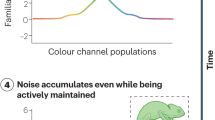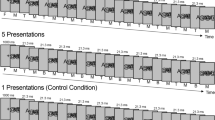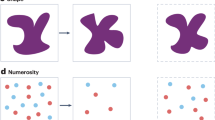Abstract
THE duration of visual persistence (iconic memory) is inversely related, up to a point, to the duration of the inducing stimulus. This suggests that iconic memory can more properly be identified with ongoing neural processes than with the decaying contents of a sensory store. Since the publication of Sperling's influential monograph1 there has been general agreement that a relatively faithful representation of a visual display remains perceptually available for several hundred milliseconds after the distal stimulus has vanished. This led to the postulation of a short-term visual store, also called iconic memory2 or sensory register3, with contents decaying rapidly after the termination of the inducing display. The terms visual persistence or icon are commonly used to refer to the perceptual availability of the decaying contents of the sensory store. Iconic memory is regarded as having temporal combinatorial properties which allow perceptual integration of two or more sequential displays even if separated by a brief temporal gap. Integration in iconic memory was convincingly demonstrated in a study where the subjects were required to identify which element in a briefly-displayed array of 16 alphabet characters had been singled out by a temporally trailing bar marker4. Temporal integration has also provided an explanation for some aspects of visual masking5 and for temporal integration of patterns whose parts were presented sequentially in time6,7. Here I question the view that iconic memory is a store whose contents begin to decay when the inducing stimulus is terminated. I suggest that the duration of iconic persistence is linked to the duration of visual processes which begin at the onset of stimulation and continue for a given duration, whether or not the inducing stimulus is still on display. This view is based on the finding that the duration of visual persistence is negatively related to the duration of the inducing stimulus.
This is a preview of subscription content, access via your institution
Access options
Subscribe to this journal
Receive 51 print issues and online access
$199.00 per year
only $3.90 per issue
Buy this article
- Purchase on Springer Link
- Instant access to full article PDF
Prices may be subject to local taxes which are calculated during checkout
Similar content being viewed by others
References
Sperling, G. Psychol. Monogr. 74, 1 (1960).
Neisser, U. Cognitive Psychology (Appleton-Century-Crofts, New York, 1967).
Atkinson, R. C. & Shiffrin, R. H. in Psychology of Learning and Motivation: Advances in Research and Theory 2, 89 (eds Spence, K. W. & Spence, J. T.) (Academic, New York, 1968).
Averbach, E. & Sperling, G. in Symposium on Information Theory (ed. Cherry, C.) 196–211 (Butterworth, London, 1961).
Uttal, W. R. Perception Psychophys. 6, 121–128 (1969).
Eriksen, C. W. & Collins, J. F. J. exp. PhyscoL 77, 376–382 (1968).
Hogben, J. H. & Di Lollo, V. Vision Res. 14, 1059–1069 (1974).
Granit, R. Sensory Mechanisms of the Retina (Oxford University Press, New York, 1947).
Sakitt, B. Psych. Rev. 83, 257–276 (1976).
Haber, R. N. in The Adaptive Function of Imagery (ed. Segal, S. J.) 38–48 (Academic, New York, 1971).
Efron, R. Perception Psychophys. 8, 231–234 (1970).
Allport, D. A. Br. J. PsychoL 59, 395–406 (1968).
Bowen, R. W., Pola, J. & Matin, L. Vision Res. 14, 295–303 (1974).
Meyer, G. E., Lawson, R. & Cohen, W. Vision Res. 15, 569–572 (1975).
Author information
Authors and Affiliations
Rights and permissions
About this article
Cite this article
DI LOLLO, V. Temporal characteristics of iconic memory. Nature 267, 241–243 (1977). https://doi.org/10.1038/267241a0
Received:
Accepted:
Issue Date:
DOI: https://doi.org/10.1038/267241a0
This article is cited by
-
Visual percepts modify iconic memory in humans
Scientific Reports (2018)
-
Reversing the Colavita visual dominance effect
Experimental Brain Research (2011)
-
Spatiotopic and retinotopic components of iconic memory
Psychological Research (1987)
Comments
By submitting a comment you agree to abide by our Terms and Community Guidelines. If you find something abusive or that does not comply with our terms or guidelines please flag it as inappropriate.



